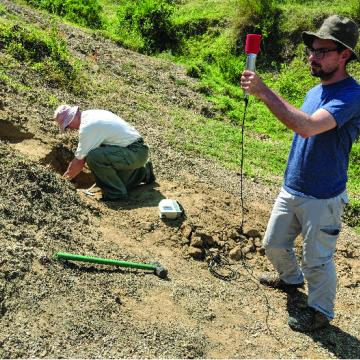Chronology and paleoecology in Kenya

Exciting School-led fieldwork this summer in Kenya seeks to revolutionise research in geochronology and paleodiet. The chronology project is focused on applying new luminescence dating methods to Plio-Pleistocene archaeological sites in Africa, where difficulties determine the age of fossils and stone tools continue to hamper human evolutionary research. Dr. Marine Frouin and Dr. Scott Blumenthal spent 7 days in the remote far north of Kenya, on the eastern shore of Lake Turkana, to collect sediment and volcanic ash samples from the Koobi Fora Formation, key to demonstrating radiofluorescence dating of feldspar minerals in non-tuffaceous sediments over the last 4 million years. This new technique will be used to date Early Stone Age sites near the shores of Lake Victoria, western Kenya, one of the most significant archives of hominin behaviour and ancient landscapes outside of the main branch of the East African rift. Frouin, Blumenthal, and Dr. Pete Ditchfield collected sediments from a number of sites which, despite 30 years of research led by colleagues Prof. Thomas Plummer (CUNY, USA), Prof. Laura Bishop (LJMU, UK), and Dr Rick Potts (Smithsonian, USA) remain poorly dated owing to the lack of suitable material for dating. These will results will provide a new way to correlate records of hominin behaviour and environments from sites across the continent. The diet project is focused on how our ancestors ate different foods seasonally, a potentially significant evolutionary driver. Like our ancestors, baboons are large-bodied, live mostly on the ground in savanna environments, and they consume a wide variety of foods. Blumenthal and Frouin visited colleague Prof. Shirley Strum (UCSD, USA), who directs of one of the longest-running studies of baboons in Africa. Baboon foods will be collected from wet and dry seasons throughout the remainder of the year for isotopic and nutritional analyses. These results, with data from baboon tissues and feces (a project initiated by Ditchield and Strum and recently revived with Blumenthal and Prof. Julia Lee-Thorp), will provide a new foundation to infer aspects of past diet seasonality from fossil tooth isotopic data.
Acknowledgements: This research was supported by NERC (NE/P013376/1), the John Fell Fund (161/067 and 171/006), and the Human Origins Program of the Smithsonian Institution.